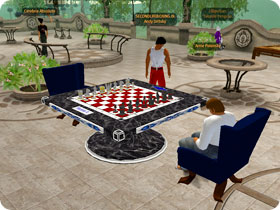
I agree. He asks me if I’ve been to Atlantis yet. “No,” I reply, so he hands me a note card with the coordinates. A couple clicks of the mouse and I teleport myself to Atlantis, where I summon a submarine that magically appears. I hop in and ride around, admiring the gorgeous architecture and rich abundance of funky sea life.
When I’m done with my tour of the underwater kingdom, I disembark and a message tells me to stop by Abbotts Aerodrome to see the latest versions of all the subs and other vehicles designed by this particular resident. I make a note of that and click the “Fly” button, using the mini-map to navigate my way back to the welcome area.

Welcome to Your Second Life. One of several places where residents gather to chat and trade tips and tricks.
Landing where I started, I’m ready to learn more about Second Life, and how I can participate in its development, as well as join other players’ social activities.
Your Canvas
“Second Life is intended to be a canvas, rather than a world that constrains residents to a specific theme or style,” explains Linden Lab vice-president of product development Cory Ondrejka. “Residents have already created areas with fantasy, sci-fi, dystopian, western and dozens of other themes. Their skills and desires determine how they experience the world, rather than the artificial limits of a typical RPG grind.”
“Second Life is beyond a game; it’s a tool for artistic freedom that brings people together.”
- Foxy Xevious, Second Life resident
In fact, not only can Second Life residents build anything they want, they own it and can share it with other residents any way they want. While that may be a revolutionary idea in the world of massively multiplayer online role-playing games (MMORPGs), Ondrejka says that it’s simply drawn from the real world, pointing out: “Economic and market forces work in digital worlds in the same way that they have always worked, from ancient Athens to the modern world.”
Giving players ownership of whatever they create — from digital vehicles to “skins” that characters can wear to change their appearance to full-fledged games that can be played within the game — is a critical way “to truly maximize growth and innovation,” according to Ondrejka. The Linden Lab team gives players the authoring and scripting tools they need to unleash their creativity, and in turn some of them have earned tens of thousands of real world dollars, thanks to Web sites that trade Linden dollars for American money.
(To learn more about three prominent Second Life residents, see “Meet the Residents” where you’ll also find more information about the history of the game and links to various web sites.)

Come With Me on a Magic Balloon Ride. This balloon tour takes you around to all the interesting places created by Linden Lab employees.
New and Better Creations All the Time
Second Life residents also constantly buy and sell parcels of land where they can store their creations. With nothing to limit them but their own imaginations, players have even built entire towns on their land, filling them with houses, sports arenas, churches, nightclubs, and more. Powerful scripting features enable them to trigger audio or even video when another resident wanders by. All of this serves to grease the wheels of social interaction within the game, encouraging players to work together as they build the digital world to even greater heights.
“We are constantly being surprised and amazed by what our residents do,” says Ondrejka. “More than any individual act of creation, the most intriguing result is the impact of increasing skill, improvements to the features, and the commoditization pressure of the economy.”
“The combination of these factors means that we’re constantly seeing new and better creations within the world. This improvement is reflected in the fact that the real-world value of items bought and sold in the game more than doubled in a year.”
According to Ondrejka, in May 2005, over 500 Second Life residents earned at least $100 each and more than 150 of them brought in over $400 apiece.
Game Hardware
Check out our systems for your best gaming experience.
- Site: Second Life
- Publisher: Linden Lab
- Genre: Role-Playing Game
Game Media
Free Membership
Joining Second Life is totally free, so why not give this immersive virtual world a spin?
Download the game now

A Second Life For Teens
Now teenagers can join in the fun using their own seperate world with Teen Second Life — away from the adult one (18 and older) where there could possibly be exposure to explicit content.
“Second Life is intended to be a canvas, rather than a world that constrains residents to a specific theme or style.”
- Cory Ondrejka, Linden Lab vice-president of product development

Sixty of them accumulated $1,000 while almost 20 earned at least $2,000 and one even made more than $38,000. All told, 1.3 million transactions totaling $1.47 million happened between 19,500 unique users. Of course, players who aren’t interested in a full- or part-time jobs creating and selling stuff can simply participate in the social activities and enjoy the fruits of other residents’ labor.

Be Anyone You Want. Choose from an amazing variety of avatar-tweaking functions.
Personal Creativity Drives the Community
Many complicated projects, such as games within the game or the machinima movies (see Foxy Xevious’ profile to learn more), require that residents work together to accomplish their goals. Ondrejka points out that “there are hundreds of classes a week within Second Life, where amateur-to-amateur teaching and learning takes place. These classes act as a primary driver for the continuously increasing quality of work within the game.”
Some players have even seen their work resonate beyond the digital boundaries of the game. For example, Nathan Keir invented a game called Tringo, and sold the worldwide rights to Donnorwood Media after discovering that Donnorwood founder Sean Ryan was one of the Second Life residents enjoying his creation. “The Wall Street Journal” covered the deal, remarking that “Tringo became an addictive hit in Second Life and now, in an unusual deal, it has a ticket out of virtual reality.”

Searching for the Bobby Fischer of Second Life. A chess board created by a resident.
Researchers at Massachusetts General Hospital have even taken a liking to Second Life, according to Ondrejka. “They’ve been working with Asperger’s Syndrome sufferers on utilizing mediated communication within the game to improve their real-world lives,” he explains.
In fact, Ondrejka thinks that Linden Lab may have discovered the magical formula that brings role-playing games out of the niche market it occupies. “The explosion of blogging and the success of Wikipedia demonstrate that personal creativity is already driving the creation of online communities,” he says. “Second Life, with its unique ability to translate those creative acts into shared, immersive 3D experiences, offers a tantalizing glimpse into the future of digital worlds.”


